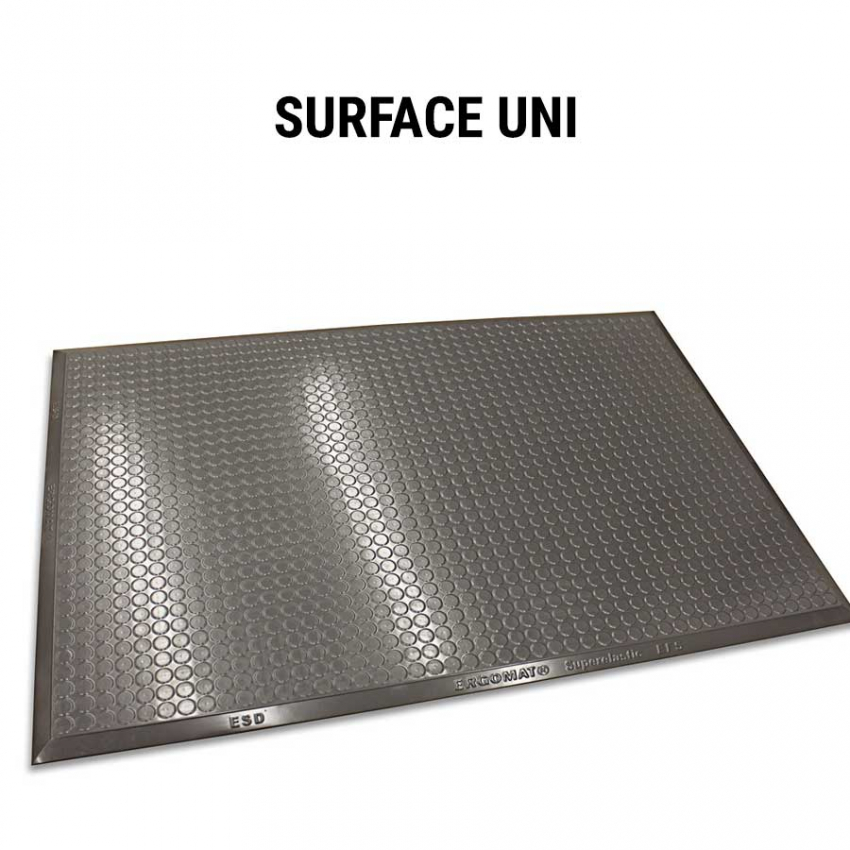






















Indoor traffic - Heavy traffic
This made-to-measure anti-fatigue mat is made of polyurethane and is resistant to intensive operator traffic. It resists moderate splashes of oils and other liquids. All shapes possible. Stimulates circulation in the feet, legs and lower back, and strengthens muscular response.
Available in standard and custom sizes.
Available in ESD version.
Several versions are available:
- UNI version for operators on the move.
- UNI ESD version for operators who move and handle objects containing electricity.
- BULLETED version for operators who only stomp.
- BULLETED ESD version for operators who only tread and handle objects containing electricity.
- DELUXE version (UNI surface with 15mm thickness) for operators whose work requires considerable pivoting.
- Available with yellow bevelled edges and/or drainage holes on request.
Other:
- Moderate exposure to oils and other liquids
- Flame-retardant
- Custom sizes and shapes available
- Beveled edges
- Silicone- and latex-free
- 5-year warranty
RECOMMENDED APPLICATIONS:
Suitable for use in dry environments such as manufacturing plants, assembly lines, packaging, logistics warehouses, individual workstations, CNC machines, metal working...
![]()
| Ergomat Complete Uni |
Data sheet
| Properties | Anti-fatigue ESD / AS Fire resistant |
| Composition | Polyurethane |
| Thickness | BULLETS 15 mm DELUXE 15mm UNI 11 mm |
| Fire classification | Cfl-s1 |
| Operating temperature | 5°C to 35°C |
| Intensity of use | Very intense |
| Hardness | 22-30 Sh A DIN53505 |
Industrial mats meet the needs of ergonomic workstations and employee well-being.
They prevent:
There are many uses for industrial mats:
Safety criteria: The mat must cover the entire workstation, be firmly attached to the floor, not shift or slide, and have bevelled edges to prevent falls.
Thickness and flexibility criteria: Contrary to what you might think, you shouldn't choose a very thick or very soft mat. The mat should have a certain elasticity, but still allow a comfortable standing position, without the user feeling slumped.
Environmental criteria :
Environmental hazard criteria : To establish more precise characteristics for a mat (antistatic properties or fire resistance etc...) we need to take into account the hazards present in the environment where the mat will be installed.
Where hazardous liquids are present in the working environment, the anti-slip properties and chemical resistance of industrial mats should be taken into account. The presence of openings on mats to allow the evacuation of fluids is essential.
Traffic criteria: We need to take into account the traffic that takes place on the equipment: how many workers can walk on it? How often, etc., in order to choose the most suitable mat.
Prevent the many problems associated with poor workstation ergonomics: RSI, static shock, bacterial proliferation, etc.
We offer a wide choice of industrial mats: on rolls, in standard sizes, made-to-measure or modular mats to suit all types of workstations.